Artificial intelligence, or AI, is a thrilling and mysterious subject, much like a captivating science fiction book you can’t put down. However, beyond fiction, AI is a reality, and its history is just as fascinating. Can you imagine a machine that learns, thinks, and adapts? Sounds incredible, right? Well, that’s precisely what AI aims to achieve.
The AI journey began in the 1950s when visionaries like Alan Turing dreamt of creating machines capable of thinking like us. Over the years, AI has gone through various stages, resembling a roller coaster of emotions and discoveries. For instance, artificial neural networks marked a significant milestone on this path, like finding a treasure map that led us to a new level of understanding.
Today, deep learning is one of the most exciting and promising techniques in the AI world. It’s as if we had a super detective capable of finding patterns and connections in mountains of data. But make no mistake, this super detective is not infallible, and its success depends on the data and algorithms that we, as humans, provide.
Now, even though AI may seem magical and astounding, it’s essential to remember that it’s neither a pure nor perfect intelligence. AI is like a talented artist who creates masterpieces using the tools and materials we provide. However, just like an artist, AI can make mistakes, and its work may be affected by the materials and tools we use.
So, what does all this mean? It means that AI is a human creation, a powerful tool that helps us organize and summarize information but is not infallible. AI is like a blank canvas that we, as humans, must fill with data, algorithms, and our creativity to achieve astonishing results.
But how does AI actually work? At its core, AI is a set of computational algorithms designed to simulate human intelligence. It involves processing large amounts of data, identifying patterns, and learning from these patterns to make decisions or predictions. There are different types of AI, such as machine learning, which focuses on training systems to learn from data and improve over time, and natural language processing, which enables AI to understand and interact with humans through language. By combining these techniques and using the right algorithms, AI systems can carry out tasks that would typically require human intelligence, such as image recognition, speech recognition, and even problem-solving. So, in essence, AI is the art and science of teaching machines to think and learn like humans, but it’s essential to remember that their performance ultimately depends on the data and algorithms we provide.
AI is exciting and promising, but we must also be aware of the risks and challenges it may bring. Like a fire that warms us and provides light but can also spiral out of control if not handled carefully, AI must be approached with caution and responsibility.
Therefore, one of the priorities in the AI world should be to consider smart regulation that allows us to harness its full potential while also preventing issues and ensuring the protection of our rights and freedoms. Regulation shouldn’t be an obstacle to innovation but a framework that promotes safe and ethical development of this technology.
As a society, we must collaborate and maintain open dialogue to find the right balance between the freedom to innovate and the need to protect people from potential abuse or risks. This path won’t be easy and will require everyone’s participation, from AI experts to lawmakers, businesses, and citizens.
So, instead of fearing AI, let’s face its challenges and work together to build a future where artificial intelligence and human intelligence coexist harmoniously, guided by smart regulations that protect and empower our lives. Like an orchestra where each instrument has its place and function, let’s make AI a valuable and safe tool in the symphony of humanity.
As for myself, I’m trying to keep an open mind to absorb more knowledge about this technology and find areas in my life where AI can be of great use. One of my favorite uses is clustering and summarizing information. For example, I use tools like ChatGPT to obtain summaries of texts and identify specific information based on the interests and filters I include in a ChatGPT prompt.
It also helps me when writing code. So far, the best use of ChatGPT in code writing is to generate annotations for snippets I don’t recognize and assist me in creating unit tests.
So, friends, let’s dive together into this fascinating world of artificial intelligence. Let’s learn, explore, and make the most of everything AI has to offer. May our adventure be filled with surprises, learning, and exhilarating moments! After all, as in a science fiction movie, the future awaits us, and we are the protagonists of this incredible story. Until next time, and may AI be with us!

Leave a Reply